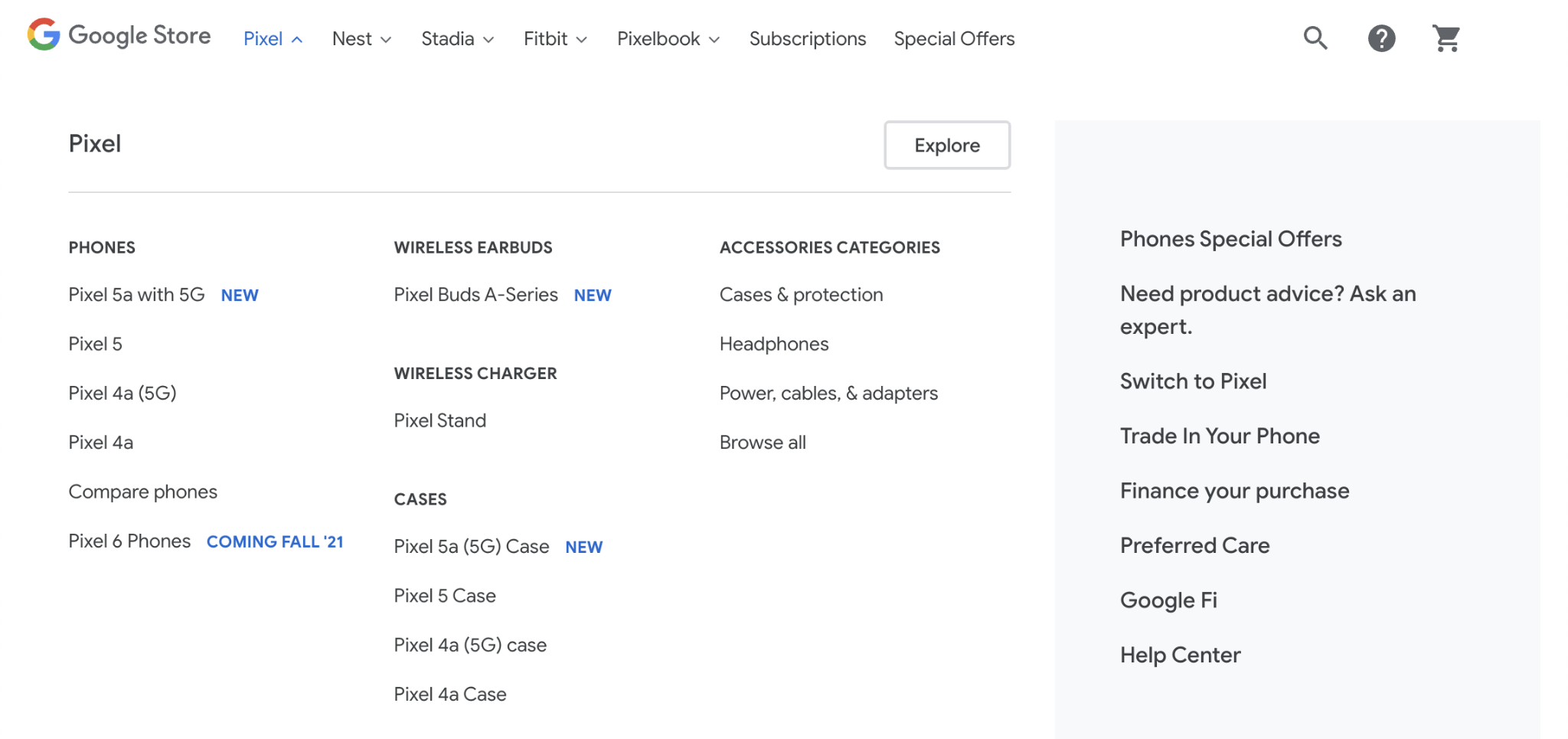ช่วยให้ Google เข้าใจโครงสร้างเว็บไซต์อีคอมเมิร์ซของคุณ
Google พยายามที่จะค้นหาเนื้อหาที่ดีที่สุดในเว็บไซต์โดยการวิเคราะห์ความสัมพันธ์ระหว่างหน้าเว็บต่างๆ ตามการลิงก์ ซึ่งหมายความว่าโครงสร้างการไปยังส่วนต่างๆ ในเว็บไซต์ (เช่น เมนูและลิงก์ข้ามหน้า) อาจส่งผลต่อความเข้าใจของ Google เกี่ยวกับโครงสร้างเว็บไซต์
ตัวอย่างเช่น Google สามารถใช้ข้อมูลอย่างจำนวนลิงก์ที่ต้องติดตามในการเข้าถึงหน้าและจำนวนลิงก์ไปยังหน้าเว็บ เพื่ออนุมานความสำคัญที่เกี่ยวข้องของหน้าเว็บหนึ่งเมื่อเทียบกับหน้าอื่นๆ ในเว็บไซต์ ดูข้อมูลเพิ่มเติมเกี่ยวกับวิธีที่ Google Search พิจารณาความสำคัญของหน้าเว็บได้ที่วิธีการทำงานของ Google Search
ทำให้การไปยังส่วนต่างๆ ในเว็บไซต์อีคอมเมิร์ซเหมาะกับ Crawler ของ Google
โปรดตรวจสอบว่าคุณได้ทำตามแนวทางปฏิบัติแนะนำทั้งหมดของเว็บไซต์อีคอมเมิร์ซและผู้คนสามารถเข้าถึงหน้าเว็บของคุณโดยการไปตามลิงก์ผ่านการนำทางของเว็บไซต์ เพื่อช่วยให้ Google พบหน้าทั้งหมดในเว็บไซต์ ตัวอย่างเช่น เพิ่มลิงก์จากเมนูลงในหน้าหมวดหมู่ จากหน้าหมวดหมู่ลงในหน้าหมวดหมู่ย่อย และสุดท้ายจากหน้าหมวดหมู่ย่อยลงในหน้าผลิตภัณฑ์ทั้งหมด เราขอแนะนำให้เพิ่ม Structured Data ด้วย เนื่องจากจะช่วยให้ Google เข้าใจวัตถุประสงค์ของหน้าต่างๆ ในเว็บไซต์เพื่อเป็นการเสริมโครงสร้างนี้

หากหน้าหมวดหมู่ไม่มีลิงก์โดยตรงไปยังผลิตภัณฑ์ทั้งหมดในหมวดหมู่หนึ่ง Googlebot อาจไม่พบผลิตภัณฑ์ทั้งหมดจากการรวบรวมข้อมูลเพียงอย่างเดียว ผลิตภัณฑ์เหล่านี้อาจเข้าถึงได้จากช่องค้นหา แต่เข้าถึงผ่านการเรียกดูหมวดหมู่ไม่ได้ โดยทั่วไป Googlebot จะไม่พยายามส่งคำค้นหาลงในช่องค้นหาเมื่อรวบรวมข้อมูลเว็บไซต์ เราขอแนะนำอย่างยิ่งให้ลิงก์ไปยังผลิตภัณฑ์ทั้งหมดที่ต้องการจัดทำดัชนี หากลิงก์กับทุกหน้าไม่ได้ ให้ใช้sitemapหรือฟีด Google Merchant Center แหล่งที่มาเหล่านี้อาจมีลิงก์ไปยังหน้าเว็บในเว็บไซต์ที่ Crawler จะไม่พบ
ให้ใช้แท็ก <a href> เมื่อสร้างลิงก์ไปยังเนื้อหาอื่นๆ เพื่อให้ Googlebot หาลิงก์ได้อย่างถูกต้อง อย่าใช้เหตุการณ์ JavaScript ในเอลิเมนต์ของ HTML DOM อื่นๆ สำหรับการไปยังส่วนต่างๆ หากต้องการดูข้อมูลเพิ่มเติมเกี่ยวกับ JavaScript และการจัดทำดัชนีเนื้อหาของหน้า โปรดอ่านหัวข้อทำความเข้าใจหลักการพื้นฐานของ JavaScript SEO
โปรโมตหมวดหมู่หรือผลิตภัณฑ์ที่ดีที่สุด
โดยทั่วไป Google จะไม่ดูโครงสร้างของ URL ในการพิจารณาโครงสร้างของเว็บไซต์ แต่จะวิเคราะห์การลิงก์ระหว่างหน้าเพื่อให้ทราบข้อมูลเชิงลึกเกี่ยวกับความสำคัญที่เกี่ยวข้องของหน้าต่างๆ ในเว็บไซต์ ตามกฎโดยทั่วไป ยิ่งมีลิงก์มายังหน้าเว็บมากเท่าไรในเว็บไซต์ หน้าดังกล่าวก็จะยิ่งมีความสำคัญที่เกี่ยวข้องกับหน้าอื่นๆ ในเว็บไซต์มากขึ้นเท่านั้น
ตัวอย่างเช่น หากคุณมีผลิตภัณฑ์ขายดี ให้ลองลิงก์ไปยังผลิตภัณฑ์ดังกล่าวจากหน้าแรกหรือในเนื้อหาอื่นๆ เช่น บล็อกโพสต์หรือจดหมายข่าวในเว็บไซต์ ซึ่งจะช่วยให้ Google เข้าใจว่าผลิตภัณฑ์มีความสำคัญเกี่ยวข้องกับเว็บไซต์ของคุณมากน้อยเพียงใด
และเมื่อพิจารณาจากที่กล่าวมาทั้งหมด จะเห็นว่า Google พยายามช่วยให้ผู้ใช้ค้นพบสิ่งที่ต้องการ แนวทางปฏิบัติแนะนำด้าน SEO สำหรับอีคอมเมิร์ซที่สำคัญที่สุดคือการสร้างเนื้อหาที่เป็นประโยชน์และน่าสนใจซึ่งมีคุณค่าต่อผู้ใช้
นอกจากนี้ ยังอ่านเพิ่มเติมได้ที่การจัดการการ Crawl ของ URL การไปยังส่วนต่างๆ ตามข้อมูลประกอบ
